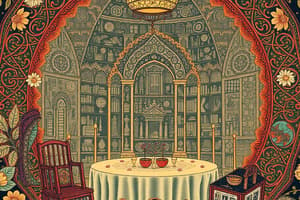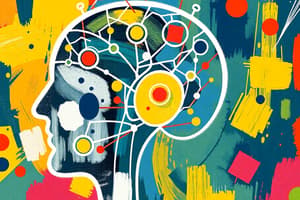Podcast
Questions and Answers
What is one of the primary reasons companies want to establish relationships with their customers?
What is one of the primary reasons companies want to establish relationships with their customers?
What is a benefit of reduced customer churn for companies?
What is a benefit of reduced customer churn for companies?
What is one advantage of customer loyalty for customers themselves?
What is one advantage of customer loyalty for customers themselves?
What is the impact of a 10% churn rate on customer numbers compared to a 5% churn rate?
What is the impact of a 10% churn rate on customer numbers compared to a 5% churn rate?
Signup and view all the answers
What is a resulting benefit of connecting customer retention to customer tenure?
What is a resulting benefit of connecting customer retention to customer tenure?
Signup and view all the answers
What is one organizational benefit of managing customer retention?
What is one organizational benefit of managing customer retention?
Signup and view all the answers
What is customer lifetime value comprised of?
What is customer lifetime value comprised of?
Signup and view all the answers
What is a key outcome when suppliers understand customer needs?
What is a key outcome when suppliers understand customer needs?
Signup and view all the answers
Why might a customer appear less profitable once costs are taken into account?
Why might a customer appear less profitable once costs are taken into account?
Signup and view all the answers
What is one of the causes of profit margin growth over time?
What is one of the causes of profit margin growth over time?
Signup and view all the answers
What is the typical result of deepening relationships between customers and suppliers?
What is the typical result of deepening relationships between customers and suppliers?
Signup and view all the answers
What is a key concept in CRM?
What is a key concept in CRM?
Signup and view all the answers
What is the characteristic of a 'Loyal customer'?
What is the characteristic of a 'Loyal customer'?
Signup and view all the answers
What is required to compute customer lifetime value?
What is required to compute customer lifetime value?
Signup and view all the answers
What is the primary goal of identifying a customer's target market profile?
What is the primary goal of identifying a customer's target market profile?
Signup and view all the answers
What is the final stage of the customer journey?
What is the final stage of the customer journey?
Signup and view all the answers
When do B2B companies not want relationships?
When do B2B companies not want relationships?
Signup and view all the answers
What is the primary benefit of gaining a 'Majority customer'?
What is the primary benefit of gaining a 'Majority customer'?
Signup and view all the answers
Study Notes
Customer Lifetime Value (CLV)
- The total present-day value of a customer is the sum of all past net margins compounded to today's value and all future net margins discounted to today's value.
- The potential value of a customer is all future net margins discounted to today's value.
Four Causes of Profit Margin Growth over Time
- Revenues grow over time as customers buy more.
- Cost-to-serve is lower for existing customers, as both supplier and customer understand each other.
- Higher prices are paid by existing customers than new customers.
- Value-generating referrals are made by existing, satisfied customers through their unpaid advocacy.
Computing CLV
- Insight into future buying behavior probabilities of buying products over the next x time periods.
- Margins earned from those products.
- Periodic costs of customer management.
- Costs of customer acquisition (for new customers).
- Discount rate.
Building Relationships
- Companies want relationships with customers to identify, satisfy, and retain profitable customers.
- Benefits of relationships include:
- Reduced customer churn
- Larger customer base
- Longer average customer tenure
- Reduced marketing costs to replace defected customers
- Better understanding of customer requirements
- More cross-selling opportunities
- Customer loyalty
Attributes of High-Quality Relationships
- Core attributes:
- Trust
- Commitment
- Additional attributes:
- Relationship satisfaction
- Mutual goals
- Cooperative norms
Advantages of Customer Loyalty
- For companies:
- Lower management costs
- Lower promotion costs
- Constant and increasing incomes
- Positive word of mouth
- Cross-selling
- Innovative and customized offered mix
- Premium price
- Stimulated staff
- For customers:
- Unitary profit per customer
Impact of Churn on Customer Numbers
- Companies with lower churn rates (e.g., 5% churn) retain more customers over time compared to companies with higher churn rates (e.g., 10% churn).
Connecting Customer Retention to Customer Tenure
- As customer retention rates increase, average customer tenure also increases.
Organizational Benefits from Managing Customer Retention
- Reduced marketing costs
- Better customer insight
- Suppliers are able to develop a better understanding of customer requirements and expectations.
The Customer Journey
- Suspect: potential customer who fits the target market profile
- Prospect: customer being approached for the first time
- First-time customer: customer makes a first purchase
- Repeat customer: customer makes additional purchases
- Majority customer: your offer plays a minor role in the customer's portfolio
- Loyal customer: customer is resistant to switching suppliers and has a strong positive attitude to your company or offer.
Studying That Suits You
Use AI to generate personalized quizzes and flashcards to suit your learning preferences.
Description
This quiz covers the essential attributes of strong relationships, including trust, commitment, and mutual goals. Learn how companies benefit from managing customer relationships effectively.




